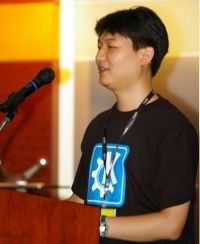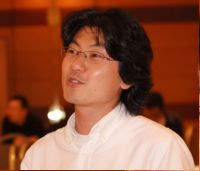KDE in Korea
Following our interview covering KDE in Japan last week, we now turn to South Korea. Cho Sung Jae tell us about the Korean KDE Users Group, including some of the problems of using KDE with Korean and just how fast their broadband is.

조성재, Cho Sung Jae
How did the Korean KDE Users Group start?
The Korean KDE Users Group was started in 1999 by Kabby (Kim Kyoung Heon). But it was not active. In 2006, Kabby recommended for me as Translation coordinator, then our team had activity to bring information about KDE in public.
What does the Korean KDE Users Group do?
The group's work, is mostly translation. Park, "segfault" Joon-Kyu has developed programs like KLDraw and galmuri. He also patched the Hangul encoding environment for Qt 3.x, so we thank him. :) And individually team members give information about KDE around to people.
How many people are part of the group?
I don't know exactly. :) For formal commiters there are 3. Me, Park "segfault" Joon-Kyu, and Park Shin-Jo. But I think that many KDE users in Korea are Korean team members. Because they bring the tips, posts, information about KDE to present about our projects. So I wanna say thanks for some special KDE Users. atie is the Kubuntu Translation contributor. He's translating in Launchpad, sometimes he posts news about KDE to KLDP (The Greatest Linux User BBS in Korea).
barosl is posting about KDE and Hangul (Korean character set) in his blog and is an older translator than me. Ziriz (sounds in English like [ziriz], but in Korean '지리즈') is good fan for KDE. He is resolving the problems in the KDE desktop with Korean. Kim Sung-Joon is also a good user. Hong Chan-Beom is the great brother of KDE team. He's bring the information about parallel computing and Bio-informatics. Hong Won-Beom is anthropologist and is studying about our society (free/open source software society) in Korea. Krisna is the developer of Korean Input System, and he's supporting KDE input method environment. Of course, I also thank every KDE users in Korea.
Why do we rarely hear from Korea in the free software world?
I think the reason is complex to explain. :) The first reason is the environment. Many Korean people are using MS's products. They don't know about Free software. If some Korean developed the program (as like Star UML), most Korean computer user wouldn't know about that program. So many Korean developers have developed free software in a web environment for Korean people. For example, as like jsboard, Gnu-board, Tatter-Tools and zeroboard. In Korea, here are many contributors to distributions, translation, input method systems, design, kernel, etc. But they are not core developers in their projects. So they are not well known. But I believe Korean contributors are increasing and they will become well-known. If you want to check Korean Free Software Contributors, please visit the KoreanOpenSourceCommitter page.
How popular is free software in Korea?
Most people don't know they are using Free Software with Apache, GNU/Linux, FreeBSD, etc. In web programming environment, computer programmers know about Python, Ruby, PHP, MySQL, Apache. (Oh! God! I coundn't stand for this.) For example, in University, many professors in computer science and computer engineering know about free software but can't use. As for students? Maybe they are studying and using. The young people are using Firefox, dev-c++, Qt and GTK in their report. But don't worry. Places which use free software are increasing. Many people engaged in a social movement are studying and using free software. They are making a film with GNU/Linux systems, have meetings to bring information about Free Software. I also engage in the social movement, and am making the nonprofit cooperation to bring people to meet free software. (Of course I have the plan to show KDE project.)
What are the most popular Linux distributions and software in Korea?
As you know, Ubuntu is the most popular distribution in Linux users group, Fedora is the most popular in general. The Firefox is the best well-known program.
Back in 2002 Hancom got a large government contract, is that still in place? http://dot.kde.org/1011075072/
It's bad news for you. Hancom went bankrupt in 2004. (That company was not related with Hannsoft which the biggest software cooperation in Korea.) After that time, the Hancom Linux developer team was moved to Haansoft, then they distributed Haansoft Linux. Until desktop version 2, they used KDE desktop for their distribution, after then they changed their default desktop environment to Gnome to develop a Hangul Word Processor.
What are some of the issues with supporting Korean writing in software?
The input method system, is known as SCIM. SCIM is developed by Chinese developers. But that is not useful on its own for Korean. The difference from Chinese and Japanese, is in the complex input system. In the Chinese and Japanese input method system they write English characters with the same pronounciation then change that to their character. But in Korean we type their character key (with consonant and vowel), then the input method system makes one compound character with those keys. krisna is developing the input method system Nabi, and library for Korean libhangul. SCIM also supports libhangul and the Korean Input system. But that's not as good as it could be for Korean, nabi is the best for us. And... Hmmm... Maybe I need to ask about that to krisna.

Krisna, libhangul developer
krisna There are many issues. There are no typical configuration tools for Input Method Systems. There is a lack of desktop integration with input method system. As you said, the difference of input method system between Korean and C(hina)J(apan). The distributed effort with Korean problem in Korea. No mailing list for Korean Input Method system. The loss of last character key input in Korea when input focus is moved. Maybe that's all.
Hmmm... That's very many things. The other issue is fonts. In Korea, there are few free/open Korean font. Unfonts and alee-fonts. That's all. That's not enough to use in a desktop environment. That problem is caused by the many compound characters. In Korean characters, there are 14 consonants and 10 base vowels. Base vowels are able to compound vowels, there are 11 compounded vowels. One Korean character has 3 sound position for each consonants and vowels. So the total compound characters are about 1.6 million. Could you make the fonts for Korean? Ah! It's too hard to make the set of Korean fonts. So many Korean Linux Users are using two font packages generally, some buy the commercial fonts to use.
In the KDE project, the problem is easily found. In KSpread, Korean characters are not able to be inputed because KSpread's focus tracking system make interrupt for Korean Input Method System. While inputing Korean characters the Input Method System need to keep focus to make the whole compound character and word. But KSpread snatchs the focus from the Input Method. I know there is no evil intention. But I couldn't recommend to people to use KOffice yet.
How well does KDE and KDE distributions support Korean writing?
After developing nabi-0.17, libhangul, Qt library's patches and improving CJK environment, supporting Korean writing is good for KDE and KDE distributions, especially KDE 4. Konqueror's address input form couldn't use CJK characters for web shortcut site's query, except for that all things are good for use. (Thanks for all the KDE developers.) But problems still exist with post codes, phone number format, address format, time showing format, currency mark (Won, ₩), Konqueror's shorcuts, and web environment API supporting. Maybe if these problems are resolved, Korean KDE user numbers will explode.
Are you in contact with KDE users in other oriental countries?
Really Few. Khoem Sokhem, he is in Cambodia. He is good person. I met him in Akademy 2006 in first. After that time we sent some messages. Except for him, I just met some oriental people in conference and events.
How active is the translation community for KDE in Korea?
Actually, I'm meeting many KDE users in offline. (I know that's really old fashioned method.) But they're feeling easy to request. If someone request translation of KDE application by e-mail, I forward the messages to Park Shin-Jo and we're trying to translate them. That's all. (I don't know why my team is active.)
Are there any KDE developers in Korea and how can we get more?
Park, "segfault", Joon-Kyu is developing KLDraw and galmuri. And I'll be the other one. :) I think there is little information about KDE. I'm also trying to translate many development documents from Trolltech and KDE sites. Maybe the problem is caused by my laziness. Korean Developers are not familiar with KDE and English Documents. So I'm trying to bring the articles about KDevelop and KDE environment to Microsoftware which is the oldest IT magazine. Recently a book about Qt development is published by Seo Young-Jin. That'll be also a good feature for increasing KDE developers.
And the Korean developer's environments need to improve. To make free software, they need to be free, but most of them are not. The work is too much to develop free software. Korean company's CEOs don't like them to develop free software. Maybe they think developers have no work to their own jobs for them. So they're increasing the work. If there are no more work, they'll bring jobs which need to use a fixed computer. :( The South Korean government planned to support the open source community with a large budget. But we couldn't see a coin about that. (Ah! No. I saw the cookies for them.) The Korean Government also need to improve their own plans.
After this interview, I'll do work as the president of Korea Free/Open Source Software Association. And I need to prepare the site fossa.or.kr and fossa.kr. If I do well in my job, almost all of the above problems will be resolved. Believe it or not. :)
Lastly, is it true you get 100Mbps broadband in Korea?
Yes :)
You can find the KDE Korean Users Group in #kde on the irc.hanirc.org network.